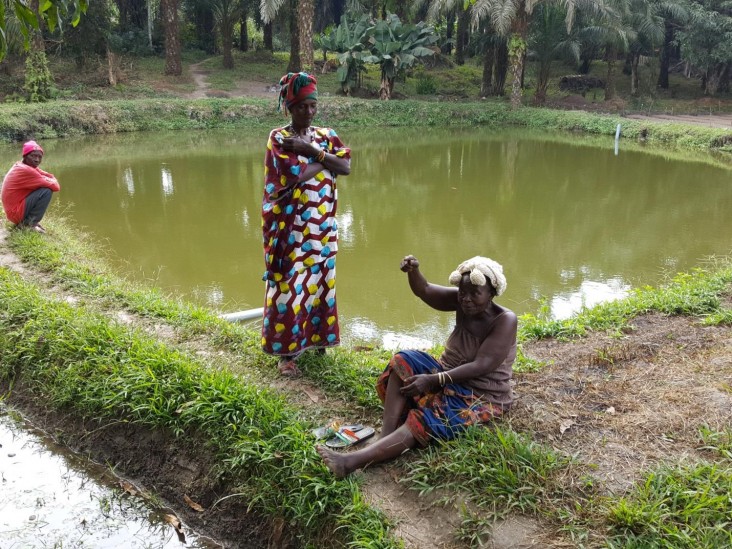Speeches Shim

‘’I had thought that fish farming was just like goat and pig rearing, or inland rice farming. But during the training sessions I learnt that fish can be harvested 3 times a year’’ Sesay said.
Hawa Sesay’s background is typical of women in rural Sierra Leone. She did not go to school, married young and manages a large household with seven children. She lives in Makumbu community in Tonkolili district. She is a rice grower whose family struggles with poverty.
Moses Bangura is also from Makumbu community. He has no permanent occupation and earns most of his revenue from low income inland rice farming and petty trade, making it hard to meet the basic needs of his family. Both Moses and Hawa explored ways that they could contribute to improve their family earnings. They both tried goat and pig rearing and chicken farming. But it was still not enough to lift their families out of poverty.
In 2015, the USAID-funded Feed the Future Scaling Up Aquaculture Production (SAP) project began implementing several new aquaculture practices in Sierra Leone to boost farmed fish production to increase food and nutrition security as well as livelihood opportunities. The focus of the project, which runs until March 2019, is the inland Tonkolili district, one of the poorest and most nutritionally insecure regions in the country. this is part of the U.S.Government efforts to help Sierra Leone assume responsibility for managing and financing its own resilience and food security challenges.
The same year, the SAP project trained small scale farmers in Makumbu community in basic fish farming techniques. Participants including Moses and Hawa learnt to carry out the following activities: building ponds, planning ahead for stocking and feeding, cleaning pondweed, and producing fish feed made with local ingredients such as cassava; monitoring and managing water levels in the pond. The project also provided participants with regular advice and with high quality tilapia fingerlings which are suited to their small ponds.
At first, Hawa didn't believe that fish farming had the potential to make a substantial difference to her family’s earnings because the concept of fish farming for business is new to her. ‘’I had thought that fish farming was just like goat and pig rearing, or inland rice farming. But during the training sessions I learnt that fish can be harvested 3 times a year’’ she said.
Fish provide a vital source of nutritional components essential for a healthy, balanced diet. It contains enough protein to fight against malnutrition that causes irreversible damage in children such as stunting their growth and inhibiting their brain development.
‘’There is high demand for fish in our communities and making fish available every three to four months is not only significantly improving our living standards, but it is also making available a cheaper and healthier alternative to beef, chicken and pork’’ Hawa said.
Members of the Makumbu community have resorted to fish farming as a better alternative to traditional farming because to them this offers more security. However, they have planted their fishpond banks with vegetables to make full use of valuable fertile ground.
Hawa has always saved enough money from her fish harvests after meeting her family’s nutrition needs. She spends this money on her children’s education and future.
‘’I use the money I earn from fish farming to provide for my son’s training at university. This was not possible when I depended on petty trade and inland rice farming,’’ Moses said.
The USAID-funded Feed the Future Scaling Up Aquaculture Production (SAP) project has trained more than 200 small-scale farmers in basic fish farming techniques and has helped to construct over 171 fish ponds across Tonkolili District. The result: fish production is increasing and the improved practices have spread to 24 other communities. These practices are now generating additional income for more than 170 households (with an average of 7 people per household) in Tonkolili.

Comment
Make a general inquiry or suggest an improvement.